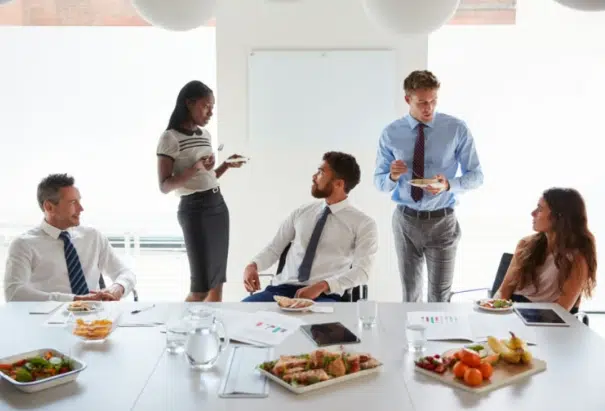In the evolving workplace, food has become a central part of company culture, employee satisfaction, and even business performance. Gone are the days when workplace dining was limited to vending machines and break room snacks. Today, companies are rethinking how food is delivered, with cafeterias taking on a much bigger role in the daily lives of employees.
Why Cafeterias Still Matter
Despite the growth of remote work and flexible schedules, cafeterias remain a vital feature for many businesses. They provide a convenient, reliable place for employees to enjoy meals without leaving the office. More importantly, they create opportunities for social interaction, which strengthens workplace culture.
An on-site cafeteria signals that the company is invested in employee well-being. It also helps businesses maintain control over the nutritional quality of meals, ensuring that employees are eating food that fuels productivity instead of slowing it down.
The Cafeteria as a Social Hub
Workplace cafeterias are more than dining halls—they are gathering spaces. They allow employees from different departments to cross paths, creating opportunities for collaboration and informal conversations. This social dynamic often improves morale and makes the workplace feel more connected.
When designed thoughtfully, cafeterias become central hubs for innovation and relationship-building. They also give businesses a chance to reinforce their brand identity through food choices, layout, and overall atmosphere.
Supporting Employee Wellness
Wellness has become one of the top priorities in modern workplaces. Employees are increasingly mindful of what they eat, and companies are responding by offering healthier, more varied cafeteria menus. Options such as plant-based meals, gluten-free alternatives, and nutrient-rich snacks are becoming standard.
Providing access to balanced meals reduces mid-day fatigue, helps employees maintain focus, and supports long-term health. In turn, companies benefit from improved productivity and fewer sick days.
The Economics of Cafeterias
At first glance, running a cafeteria may seem like an expense. However, many companies discover that it pays off in both tangible and intangible ways. Employees spend less time leaving the office for meals, leading to higher efficiency. Turnover decreases as employees appreciate the convenience and value of workplace dining.
Some companies offset costs by offering subsidized meals, while others create cafeteria programs that break even by partnering with food vendors. The financial model can vary, but the end result is the same: better food leads to happier, more engaged employees.
Customization and Flexibility
Today’s workforce values choice. Modern cafeterias are no longer serving one-size-fits-all meals. Instead, they embrace customization, offering salad bars, made-to-order stations, and menus that cater to diverse tastes and dietary needs.
Flexibility also extends to how meals are served. Some companies provide grab-and-go options for employees on tight schedules, while others emphasize sit-down meals that encourage longer breaks and conversation.
Technology in the Cafeteria
Technology is transforming workplace cafeterias. Mobile apps and self-service kiosks allow employees to order meals ahead of time, reducing wait times. Digital menus provide nutritional information and allergen details, making it easier for employees to make informed choices.
This integration of technology not only improves convenience but also enhances transparency, showing employees that the company values their health and time.
The Role of Professional Providers
Managing a cafeteria requires expertise, planning, and resources that many businesses do not have internally. That’s why many turn to outside partners to design, manage, and operate dining programs.
Partnering with corporate cafeteria companies ensures that meals are prepared consistently, food safety regulations are met, and menus evolve with employee preferences. These professional providers bring the experience and scale needed to create cafeterias that truly enhance the workplace experience.
Trends Driving the Future of Workplace Dining
As offices continue to evolve, several trends are shaping the future of cafeterias:
- Health-focused menus with fresh, seasonal, and plant-based options.
- Sustainability practices such as reducing food waste and sourcing locally.
- Hybrid dining solutions that cater to employees working part-time in the office.
- Cultural variety to reflect the diverse backgrounds of employees.
By embracing these trends, companies create cafeterias that not only feed employees but also inspire them.
Looking Ahead
Workplace cafeterias are no longer just about food—they are about creating an environment where employees feel valued, connected, and energized. Companies that invest in modern dining programs demonstrate commitment to both wellness and culture, two factors that increasingly define business success.
In the modern office, food is more than a perk. It is a tool for retention, engagement, and long-term productivity. Cafeterias remain one of the most effective ways to bring people together and build a workplace where employees can thrive.








